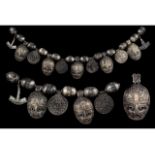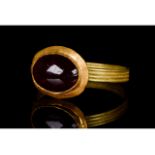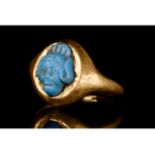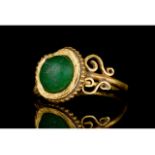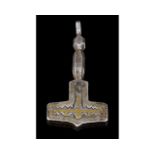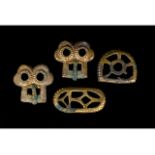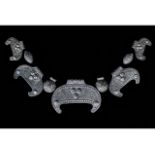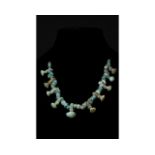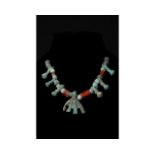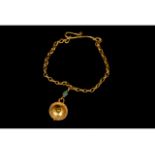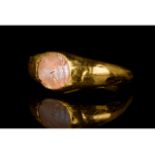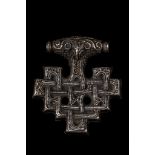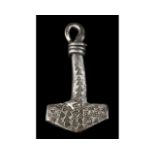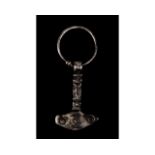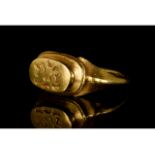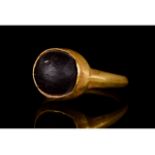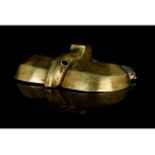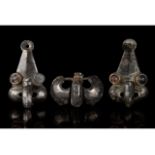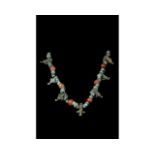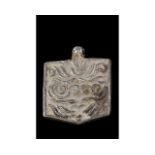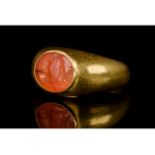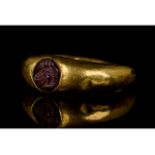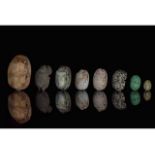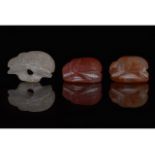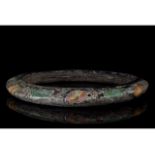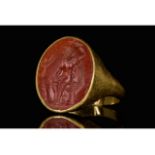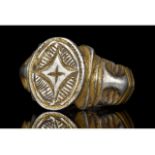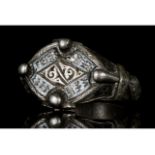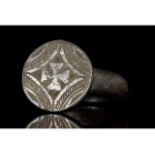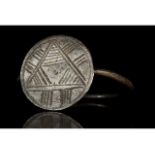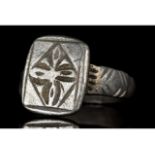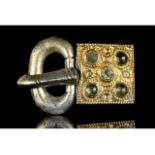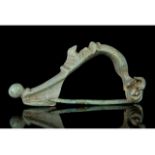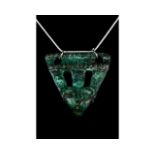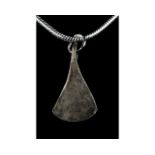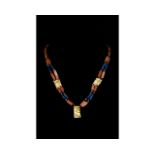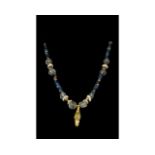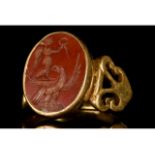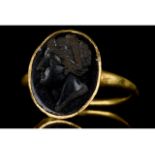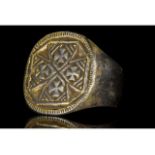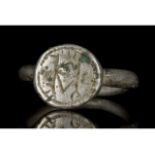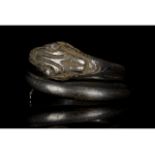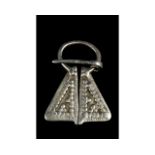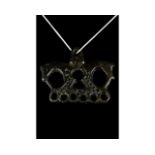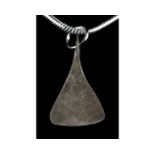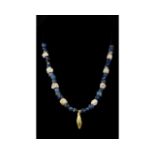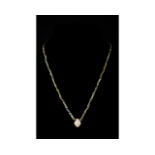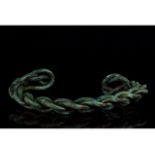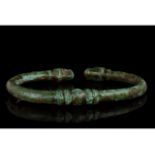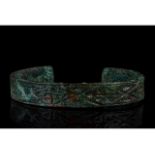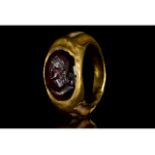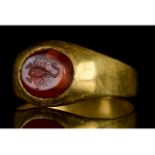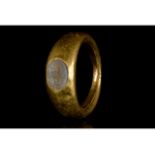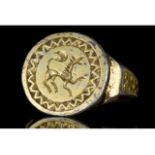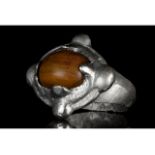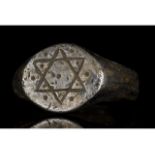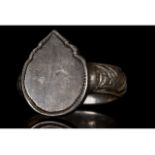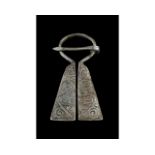Filtered by:
- Categoria
- Elenco
- Grid
A subscription to the Price Guide is required to view results for auctions ten days or older. Click here for more information
Ca. 900 AD. Viking Age. A rare silver necklace made of a single string of oval silver beads decorated with a dotted pattern. The necklace also com...
Ca. 200-400 AD. Late Roman. A wearable gold ring with an applied Roman oval bezel set with a cabochon garnet gem and a possibly later circular ban...
Ca. 500-400 BC. Phoenician. A beautiful Phoenician faience gem portraying a female figure set into a later gold ring with an oval bezel, a circula...
Ca. 200-400 AD. Late Roman. A wearable gold ring with a thin circular band, shoulders decorated with two bands of double wires, and a round bezel ...
Ca. 800-1000 AD. Viking. A beautiful silver Mjölnir ("Lightning," Thor's mighty hammer) pendant of extraordinary size with gold inlays. The gold i...
Ca. 500-600 AD. Western Europe, Merovingian, Migration Period. A set of beautiful gilded bronze belt fittings, usually held to the leather strap w...
Ca. 900-1000 AD. Viking. A very large silver filigree necklace with five lunar crescent pendants. Granulated silver forms the symmetrical swirls a...
BRONZE AGE NECKLACE WITH AMULETS
Ca. 800-600 BC. Bronze Age. A beautiful bronze necklace made of numerous stylized mace-head pendant amulets and beads of various sizes and shapes....
BRONZE AGE NECKLACE WITH AMULETS
Ca. 800-600 BC. Bronze Age. A beautiful bronze necklace made of numerous stylized mace-head pendant amulets with bronze and stone beads in a red p...
Ca. 100-300 AD. Roman. A beautiful gold bracelet with a gold chain made of small figure of eight parts, a hook clasp, and a round gold pendant wit...
Ca. 200-400 AD. Late Roman. A beautiful gold ring with a circular band made of coiled beaded wires, flared shoulders, and a round bezel with blue ...
Ca. 100-300 AD. Roman. A beautiful gold ring with a circular band, flared shoulders, and bezel decorated finely incised intaglio depicting a scene...
VIKING SILVER FILIGREE PENDANT
Ca. 900-1000 AD. Viking. A stunning silver filigree pendant in a woven, abstract form with a stylized face at the top. Granulated silver forms the...
VIKING THOR'S HAMMER SILVER AMULET
Ca. 900-1100 AD. Viking. A stunning silver pendant in the shape of a Mjölnir (Thor's hammer) decorated with typical engraved triangular marks, eac...
Ca. 900-1100 AD. Viking. A stunning silver pendant in the shape of a Mjölnir (Thor's hammer) decorated with three circles and notches above and be...
Ca. 1000-1300 AD. Holy Lands. A beautiful Crusaders or Seljuk gold ring with a circular hoop, flared shoulders with central raised ridge, and rais...
ROMAN GOLD RING WITH PURPLE GEM
Ca. 100-300 AD. Roman. A wearable gold ring with a circular band, gently flared shoulders, and applied oval bezel set with a cabochon purple gem. ...
Ca. 500-700 AD. Western Europe, Merovingian, Migration Period. A beautiful moon-shaped gold fitting with inset garnets. Good condition. At the tim...
Ca. 500-700 AD. Western Europe, Merovingian, Migration Period. A beautiful gilded silver belt buckle with inset garnets. Excellent condition. At t...
MEROVINGIAN SILVER BELT SET
Ca. 500-700 AD. Western Europe, Merovingian, Migration Period. A beautiful set of silver belt fittings with inset garnets; such fittings were usua...
BRONZE AGE NECKLACE WITH AMULETS
Ca. 800-600 BC. Bronze Age. A beautiful bronze necklace comprising numerous stylised mace-head pendant amulets and stone beads in a red palette. G...
Ca. 900-1100 AD. Viking. A beautiful square silver amulet with stylised decoration and an integral adorned suspension loop. Pendants and amulets o...
Ca. 100-300 AD. Roman. A wearable gold ring featuring a circular band, flared shoulders, and large oval bezel embellished with a finely incised in...
Ca. 100-300 AD. Roman. A beautiful gold ring featuring a circular band, flared shoulders, and a large oval bezel set with a garnet gemstone featur...
EGYPTIAN GROUP OF EIGHT SCARABS
Ca. 1674-30 BC. Second Intermediate Period - Ptolemaic Dynasty. A group of eight scarab amulets. The collection is comprised of various stone type...
EGYPTIAN TRIO OF STONE SCARABS
Ca. 664-332 BC. Late Period. A trio of stone scarabs. Two are red carnelian and one is a white stone. The red scarabs have rounded beetle-like upp...
ROMAN GLASS BRACELET
Ca. 200-400 AD. Roman. A beautiful glass bracelet with amber and opaque green-yellow glass inserts on a black, slightly corroded background. Good ...
Ca. 100-300 AD. Roman. A beautiful gold ring with a circular band, flared shoulders, and an oval bezel set with large oval red carnelian intaglio ...
Ca. 1100-1400 AD. Crusaders Period. A wearable silver ring with a heavy circular band with decorated shoulders forming a grinning mask effect and ...
Ca. 1000-1200 AD. Eastern Viking. A silver ring with a lozenge-shaped bezel engraved with runic symbols and niello decoration. The circular band a...
MEDIEVAL SILVER RING WITH CROSS
Ca. 1100-1400 AD. Crusaders Period. A wearable silver ring comprising a heavy circular band and applied circular bezel decorated with a Maltese cr...
Ca. 1100-1400 AD. Crusaders Period. A wearable silver ring comprising a thin round band and an applied circular, flat bezel whose central incised ...
MEDIEVAL SILVER CROSS WITH CROSS
Ca. 1100-1400 AD. Crusaders Period. A beautiful silver ring comprising a circular band, linearly decorated shoulders, and an applied rectangular b...
Ca. 500-700 AD. Western Europe, Merovingian. A large silver buckle comprising a round-section loop, curved tongue with the tip resting on the loop...
Ca. 100-300 AD. Roman. A rare ancient Roman trumpet - type fibula decorated with a duck head motif; preserved pin. Excellent condition. Fibulae we...
BRONZE AGE PENDANT WITH RAM HEADS
Ca. 1000 BC. Central European/Hallstatt Culture. An openwork pendant in the shape of a voided triangle decorated with two ribbed raised bands and ...
MEDIEVAL SILVER AXE SHAPED PENDANT
Ca. 700-900 AD. Northern Europe. A beautiful silver pendant with an integral loop shaped like a bearded Viking axe head. Good condition. This type...
ROMAN GLASS, CARNELIAN AND GOLD NECKLACE
Ca. 100-300 AD. Roman. A beautiful necklace made of two strings of carnelian and blue glass rectangular and flat beads with gold flat beads and th...
Ca. 100-300 AD. Roman. A beautiful restrung necklace made of circular and flat beads glass beads in a blue, black, red and white palette, gold bea...
Ca. 100-300 AD. Roman. A beautiful gold ring with a circular band with broad shoulders decorated with stylized openwork scrolling foliate design. ...
Ca. 200 BC-100 AD. Late Hellenistic/ Early Roman. A beautiful gold ring with a thin circular band and applied oval bezel set with an oval black ge...
Ca. 1100-1400 AD. Crusaders Period. A stunning gilded silver ring with a circular band and flared shoulders. The bezel is decorated with four Malt...
MEDIEVAL SILVER RING WITH PATTERN
Ca. 1100-1400 AD. Medieval Western Europe. A beautiful silver ring comprising thin circular band and an applied oval bezel featuring incised decor...
ROMANO-EGYPTIAN SILVER SNAKE RING
Ca. 100 BC-100 AD. Romano-Egyptian. A silver ring with a circular band shaped as the coiled body of a snake; the bezel in the shape of a snake hea...
MEDIEVAL SILVER PENANNULAR BROOCH
Ca. 1100-1400 AD. Medieval Western Europe. A Viking-inspired, silver omega penannular brooch featuring flanges with panels embellished with granul...
VIKING BRONZE PENDANT WITH HORSE HEADS
Ca. 1000 AD. Viking. A bifacial bronze pendant with the body shaped as a pair of horse-heads in profile, a low-relief detailing, a loop between th...
MEDIEVAL SILVER AXE SHAPED PENDANT
Ca. 700-900 AD. Northern Europe. A beautiful silver pendant with integral loop shaped like a bearded Viking axe head. This type of amulet is model...
Ca. 100-300 AD. Roman. A beautiful restrung and fully wearable necklace made of a single string of white and blue glass circular beads with gold f...
EGYPTIAN FAIENCE NECKLACE WITH AMULET
Ca. 664-30 BC. Late Period - Ptolemaic Dynasty. A necklace made of restrung glazed beads with a faience amulet of a heart as its pendant. The bead...
MEDIEVAL BRONZE TWISTED BRACELET
Ca. 900-1100 AD. Early Medieval. A beautiful Viking-inspired twisted 'fealty' bracelet or arm ring. Good Condition. Beautiful patina. Such type of...
Ca. 100-300. Roman. A penannular bronze bracelet with a round-section band featuring ribbed decoration and lozengiform terminals shaped as crested...
MEDIEVAL DECORATED BRONZE BRACELET
Ca. 900-1100 AD. Viking Age. A solid bronze bracelet decorated with geometric patterns. Good Condition; beautiful patina. In Viking society, arm r...
Ca. 100-300 AD. Roman. A wearable gold ring with ellipsoid hoop widening at the shoulders, which are embellished with parallel grooves, and a beze...
Ca. 100-300 AD. A gold ring with a circular band, flared shoulders, and an oval bezel set with a carnelian gem; the delicate intaglio depicts a sc...
Ca. 100-300 AD. Roman. A wearable gold ring with circular hoop, flared shoulders, and an oval bezel set with a chalcedony gemstone; the beautiful ...
MEDIEVAL SILVER GILDED RING WITH BEAST
Ca. 1300-1500 AD. European. A beautiful gilded silver ring with a circular band and flared shoulders decorated with a cross pattern and an oval be...
MEDIEVAL SILVER RING WITH STONE IN BEZEL
Ca. 900-1100 AD. Northern European. A beautiful silver ring comprising a lentoid-section hoop, flared shoulders, a discoid bezel with claw setting...
MEDIEVAL SILVER RING WITH STAR OF DAVID
Ca. 1300-1500 AD. A wearable silver ring with a circular band, slightly flared shoulders, and an oval bezel decorated with an incised star of Davi...
MEDIEVAL SILVER RING
Ca. 1300-1500. Medieval Europe. A beautiful silver ring with a heavy circular band with a circular raised protrusion at the base and incised decor...
MEDIEVAL SILVER PENANNULAR BROOCH
Ca. 1100-1400 AD. Medieval Western Europe. A Viking-inspired silver omega penannular brooch featuring flanges with two panels decorated with geome...

